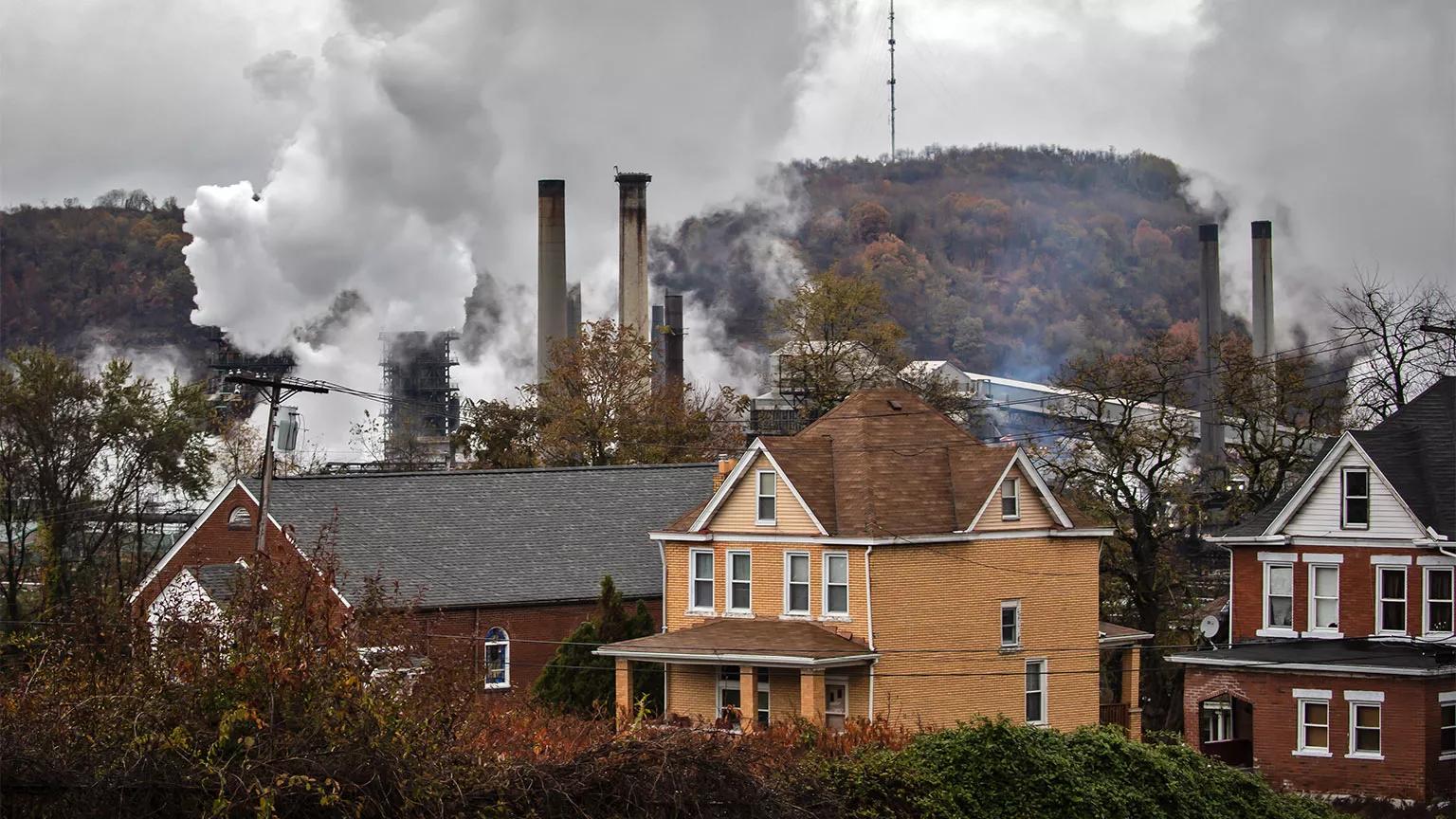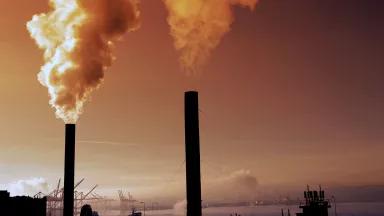Mercury’s Journey from Coal-Burning Power Plants to Your Plate
The EPA wants to lower people’s exposure to this potent neurotoxin by going after the pollutant’s biggest source.

Emissions rising from a coke plant in Allegheny County, Pennsylvania
Julie Dermansky
Unlike many air pollutants, mercury typically takes a circuitous path through the planet’s atmosphere, waterways, and wildlife before entering our bodies. The long journey, of course, doesn’t make this neurotoxin any less dangerous, and while there are steps people can take to help limit their personal mercury exposure, what’s best for all is cutting off this pollutant at its source.
This is what the U.S. Environmental Protection Agency (EPA) is planning to do in its newly issued regulations tightening mercury emissions from coal-burning power plants, the biggest source of the pollutant in the United States. The new standards, which would lower the level of allowable mercury emissions from lignite coal plants by 70 percent, would benefit the health of everyone but especially those living near the power plants, often low-income communities. They would also go far in protecting those of us who are most vulnerable to mercury’s toxic effects on the brain: children.
What is mercury and why is it so dangerous?
Mercury is an element found in the earth’s crust, but when above ground, it can cause problems due to its neurotoxicity. All forms of mercury can be harmful, but methylmercury is the most concerning because it can more easily pass through the body’s blood-brain barrier as well as the placental barrier in the wombs of pregnant women. Research has shown that exposure to methylmercury can damage brain function and development in fetuses and children. There is also a correlation between higher blood levels of mercury early in life and lower IQs.
“Exposures to methylmercury are associated with neurocognitive deficits, and the epidemiological literature shows that this does persist into adulthood,” says Elsie Sunderland, a Harvard University toxicologist and environmental scientist. Meanwhile, exposure to mercury during adulthood is linked to issues with fine motor function, verbal memory, and cardiovascular disease.
Where does mercury come from?
Contained within fossil fuels, mercury is typically trapped underground for hundreds of millions of years. But once burned, coal and oil release the mercury into the atmosphere. There, it can potentially stay airborne for more than a year and travel to remote ecosystems, especially those in the Arctic Circle, due to various environmental factors that cause mercury to accumulate in the region.
Not only does methylmercury cross the blood-brain and placental barriers, it also readily amasses in the bodies of animals and humans.
In the upper atmosphere, mercury is relatively harmless to people. But atmospheric mercury can eventually undergo a chemical reaction with sunlight and other elements—such as oxygen, sulfur, and bromine—through which it becomes a type of salt. The salt then dissolves in water vapor and falls to the earth as rain, soaking into soils and washing into waterways. In aquatic ecosystems in particular, bacteria convert some of the mercury to methylmercury, and the real trouble begins. Not only does methylmercury cross the blood-brain and placental barriers, it also readily amasses in the bodies of animals and humans.
Methylmercury contamination starts small with microscopic organisms, such as plankton taking it up. Those microbes, however, feed larger organisms, which in turn, are eaten by small fish. The small fish then become meals for bigger fish and other predators, including humans. The mercury travels up the food chain, accumulating in larger and larger quantities at each step.
For example, top predators in the Arctic—such as polar bears, belugas, narwhals, and seals—tend to have very high mercury levels, as do the people who rely on them for food. Large amounts of research have found that Arctic Indigenous populations, especially Inuit communities, face some of the highest human exposures to mercury in the world.
Who is most at risk for high mercury exposure?
The most common type of mercury exposure happens over time through the eating of contaminated foods, usually fish. This includes both ocean predators, like tuna and swordfish, and freshwater fish, such as bass and trout. A national survey conducted within the last decade estimated that as many as 19 million people in the United States who ate fish that they caught themselves three or more times a week were exposed to mercury concentrations high enough to result in adverse health effects. Low-income respondents reported some of the highest consumption rates and were consequently at higher risk. Currently, every state in the country has advisories against eating fish caught in certain waterways due to high mercury levels.
“There is no safe level of mercury exposure.”
Elsie Sunderland, Harvard University toxicologist and environmental scientist
Those who live near coal-burning power plants need to be especially careful about mercury exposure. According to Gabriel Filippelli, an earth science professor and director of Indiana University-Purdue University Indianapolis’s Environmental Resilience Institute, most mercury falls within 9 miles of a smokestack, but considering this element’s ability to get around, proximity is only part of the equation. Filippelli and a team of researchers examined soil samples downwind of a coal-fired power plant in Indianapolis and found a plume of mercury that extended more than 30 miles away. He says the White River, which flows through Indianapolis, could be transporting mercury far beyond city limits. While the state department of natural resources periodically checks fish to see if they are safe to eat, most of that sampling occurs near urban areas. Filippelli says, “There's still some risk if you go to rural Indiana, where there is no sign of industrialization at all anymore.” Those who fish there, he adds, bear a legacy of what’s happening dozens of miles upstream.
What are Mercury and Air Toxics Standards?
The Mercury and Air Toxics Standards (MATS) set limits on three pollutants: mercury, hydrochloric acid, and particulate matter. Since the original standards went into effect about a decade ago, mercury pollution from coal-fired power plants has decreased 90 percent through a combination of pollution-controlling technologies, plant closures, and changes to cleaner fuel sources. Such declines, Sunderland figures, translate to billions in public health savings. “MATS were overwhelmingly successful,” she says.
The Clean Air Act also requires the EPA to periodically review whether available technologies have improved to a degree that would warrant strengthening the standards, says John Walke, NRDC’s clean air director, who has been working on mercury pollution issues for more than two decades. Despite previous efforts by the Trump administration to roll back MATS, that tech review recently moved forward, addressing the fact that certain technologies are now known to work better on different types of coal. This is especially significant for the current weak standards for power plants that burn lignite coal, which contain especially high levels of mercury.
“The rationale at the time was that it was harder to control or limit or reduce mercury from the combustion of lignite coal. Subsequently, we've learned that's not really true. The proper technologies can actually do it quite effectively,” says Walke.
Why stronger mercury standards are necessary
The majority of coal-burning power plants nowadays emit 5 kilograms of mercury per year, according to Sunderland. This keeps exposures within the EPA’s acceptable threshold for most people. Still, as Sunderland puts it, “there is no safe level of mercury exposure.” And there are clusters of lignite-burning power plants in North Dakota and Texas, for instance, with annual mercury emissions of more than 100 kilograms. The pollution spewing from these plants is unacceptable and also unnecessary.
Relatively inexpensive technologies, such as activated carbon injection, can lower the amounts of mercury and other heavy metals, like lead and arsenic, being emitted from lignite coal, and stronger MATS will now require these upgrades. Without them, the people living near these plants—such as the Indigenous communities of North Dakota’s Fort Berthold and Spirit Lake reservations—will continue to contend with a potent neurotoxin insidiously making its way through their soils, waters, wildlife, and food.
The EPA, says NRDC’s Walke, has decided that power plants “can do more, they should do more, it's cost effective for them to do more, and it's important for public health to do more.”
This story was updated on April 25, 2024 with new information and links.
This NRDC.org story is available for online republication by news media outlets or nonprofits under these conditions: The writer(s) must be credited with a byline; you must note prominently that the story was originally published by NRDC.org and link to the original; the story cannot be edited (beyond simple things such as grammar); you can’t resell the story in any form or grant republishing rights to other outlets; you can’t republish our material wholesale or automatically—you need to select stories individually; you can’t republish the photos or graphics on our site without specific permission; you should drop us a note to let us know when you’ve used one of our stories.
We need climate action to be a top priority in Washington.
Tell President Biden and Congress to slash climate pollution and reduce our dependence on fossil fuels.









The Petcoke Problem: Where to Store the Risky Tar Sands Refining By-Product
The Particulars of PM 2.5
Protect Your Community from “Bomb Trains”